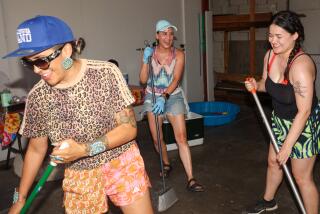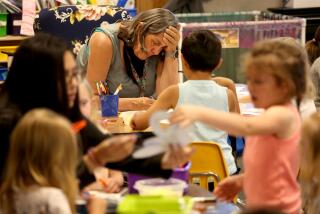Drumming It In
- Share via
In a weathered portable classroom at an aging Dana Point elementary school, students in Capistrano Unified School District learn about the area’s oldest, and often underrepresented, culture.
During a recent visit to Lobo Lodge, which houses the district’s American Indian cultural and science programs, Shayla Contla, 8, closely eyed a replica of a decorative shawl worn by Native Americans. “I came here last year, but it’s always fun,” said Shayla, who said she’s half-American Indian.
Learning about the history and culture of American Indians has always been a part of the curriculum in the county’s third-most-populous district, with much of the learning centered at Lobo Lodge at Richard Henry Dana Elementary School.
Now, the Lobo Lodge’s new director, Kogee Thomas, is working with school district officials to expand the scope of the district’s American Indian curriculum. They’re also planning to increase services for American Indian youngsters, whose needs can sometimes be overshadowed in a district in which Latinos and Asians are the largest minority groups.
Despite a relatively small population--an estimated 550 of the district’s 42,196 students are Native American --Capistrano Unified offers those students enrichment classes, tutoring, field trips and counseling through a federally funded program called Indian Education. The district received $66,000 from Indian Education for the current school year, officials said.
The goal, Thomas said, is to help students appreciate history from an American Indian perspective.
“Students walk on Indian land the minute they step out of bed,” Thomas said.
A Creek and Seminole Indian who is active in American Indian educational programs, Thomas helped reform the curriculum at Sherman Indian High school, a Riverside County program run by the U.S. Bureau of Indian Affairs. She is also director of special programs at UC Irvine.
Expanding the reach of American Indian education in Capistrano Unified will create a stronger sense of community among Native American students, while teaching others about tolerance, she said. “If you don’t have experience with other cultures, you don’t understand your own,” she added.
Thomas hopes the expansion effort will build upon local support from the Juaneno Band of Mission Indians and Mission San Juan Capistrano. The benchmark of future success will be improving academics, said Lois Madson, who helped coordinate district programs for Indian Education.
“Historically, American Indians are by far and away the lowest in . . . every kind of academic performance: dropout rate, grades, college attendance,” Madson said.
About 2.5% of Native Americans in Capistrano Unified dropped out of school that year, slightly lower than the 2.6% countywide average, according to the California Department of Education’s statistics for 1997-98 school year, the last year figures were available.
Capistrano Unified’s tutoring program for American Indians tries to address differences in learning styles, Madson said.
“[Research shows] American Indians tend to be right-brained; they use experience, and they’re visual and tactile learners,” Madson said. “They come into our European-based system and just don’t do well, even though they may be very bright.”
Traditionally, American Indians learned about culture through storytelling instead of through writing and reading, according to the American Indian Culture Research Center. This difference can lead to classroom difficulties, experts say.
Thomas is dreaming up ways to use the Lobo Lodge as a catalyst for other academic opportunities.
“I’d like to have students earn scholarship money for colleges through internships here at the center,” she said.
The lodge offers lessons in American Indian culture, arts and history. Its walls are lined with books, plants, dolls, drums, rugs, costumes, pelts and antlers--all illustrating elements of American Indian life.
“It teaches them some of the wonderful values that our society needs today, like love of the land, valuing all life forms, respect for elders and children,” Madson said. ‘We instinctively know those are good values.”
Thomas also wants to see the center grow.
She would like to regain access to the center’s former resource room, which residents used to trace family trees. Now, that room is being used as a classroom as the district scrambles to reduce class sizes and serve a steady stream of newcomers.
“Right now, space is a major problem,” said Lynn Holland, a Doheny State Beach park ranger who leads Capistrano kids through Lobo Lodge.
Getting out of the portable classroom would be just the beginning for Thomas.
“We can grow to be a model for the whole nation,” she said.
More to Read
Sign up for Essential California
The most important California stories and recommendations in your inbox every morning.
You may occasionally receive promotional content from the Los Angeles Times.









